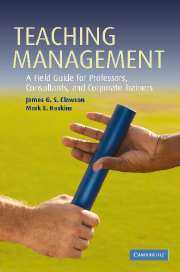Book contents
- Frontmatter
- Contents
- List of figures
- Sources to chapter quotations
- Why this book on teaching management?
- 1 Fundamental elements in teaching
- 2 Levels of learning: one, two, and three
- 3 Adult learning theory: it matters
- 4 Planning a course: trips and tips
- 5 Planning a class: no detail is too small
- 6 Lecturing: the possibilities and the perils
- 7 Managing discussions
- 8 Case method: fostering multidimensional learning
- 9 Role-playing
- 10 Case writing: crafting a vehicle of interest and impact
- 11 Case teaching notes: getting from here to there
- 12 Action learning
- 13 Experiential methods
- 14 Enhancing the conversation: audiovisual tools and techniques
- 15 Executive education: contributing to organizational competitive advantage
- 16 Using technology to teach management
- 17 Counseling students
- 18 Evaluating students: the twin tasks of certification and development
- 19 Teaching evaluations: feedback that can help and hurt
- 20 Research presentations
- 21 Managing a degree program: behind the ‘glory’
- 22 Managing a nondegree client program: an overview
- 23 Dealing with the press
- 24 Managing yourself and your time
- 25 Using teaching portfolios and course portfolios
- 26 Conclusion: is this on the exam?
- Index
16 - Using technology to teach management
Published online by Cambridge University Press: 25 February 2010
- Frontmatter
- Contents
- List of figures
- Sources to chapter quotations
- Why this book on teaching management?
- 1 Fundamental elements in teaching
- 2 Levels of learning: one, two, and three
- 3 Adult learning theory: it matters
- 4 Planning a course: trips and tips
- 5 Planning a class: no detail is too small
- 6 Lecturing: the possibilities and the perils
- 7 Managing discussions
- 8 Case method: fostering multidimensional learning
- 9 Role-playing
- 10 Case writing: crafting a vehicle of interest and impact
- 11 Case teaching notes: getting from here to there
- 12 Action learning
- 13 Experiential methods
- 14 Enhancing the conversation: audiovisual tools and techniques
- 15 Executive education: contributing to organizational competitive advantage
- 16 Using technology to teach management
- 17 Counseling students
- 18 Evaluating students: the twin tasks of certification and development
- 19 Teaching evaluations: feedback that can help and hurt
- 20 Research presentations
- 21 Managing a degree program: behind the ‘glory’
- 22 Managing a nondegree client program: an overview
- 23 Dealing with the press
- 24 Managing yourself and your time
- 25 Using teaching portfolios and course portfolios
- 26 Conclusion: is this on the exam?
- Index
Summary
Man is a tool-using animal.
– Thomas CarlyleIn this chapter, we examine the best practices for the use of technology to enrich the learning experience. The students who are now arriving in our management programs have been using computers for most of their careers. Today's typical MBA students and young managers have been computer-literate since childhood, and are capable of playing a multi-user, online game with global challengers while they listen to digital music and use Instant Messaging to interact with their friends. Some will even say they can add homework preparation to this extreme multitasking lifestyle.
Through the following perspectives, we will examine the use of technology to engage this technologically proficient generation of students in a rich learning experience:
Pre-class preparation and exercises
In-class technology use
Post-class reflection and exercises
Assignment submission tools
Team project technology support
Orchestrating the total experience.
Numerous examples of technology innovators from the leading business schools are presented in this chapter. Many thanks for their contributions to this work and to the profession.
Pre-class preparation and exercises
The use of technology to support a student's preparation for class often provides the most benefit relative to the level of instructor effort involved. School-, university-, or corporate-level resources can be leveraged without a unique development effort for a single course, if such tools are available. If not, simple-to-use tools may be implemented to enable a motivated instructor to accomplish much of what is discussed in this chapter.
- Type
- Chapter
- Information
- Teaching ManagementA Field Guide for Professors, Consultants, and Corporate Trainers, pp. 275 - 303Publisher: Cambridge University PressPrint publication year: 2006



